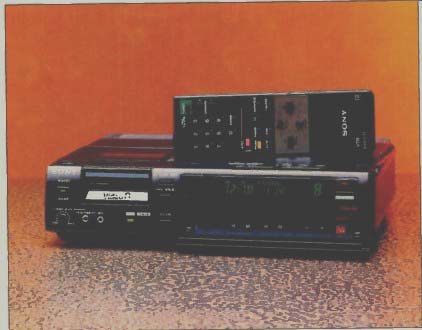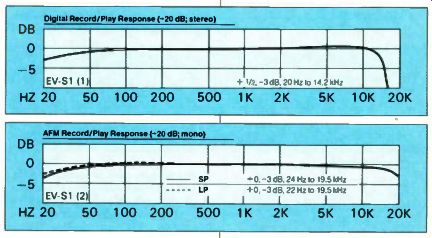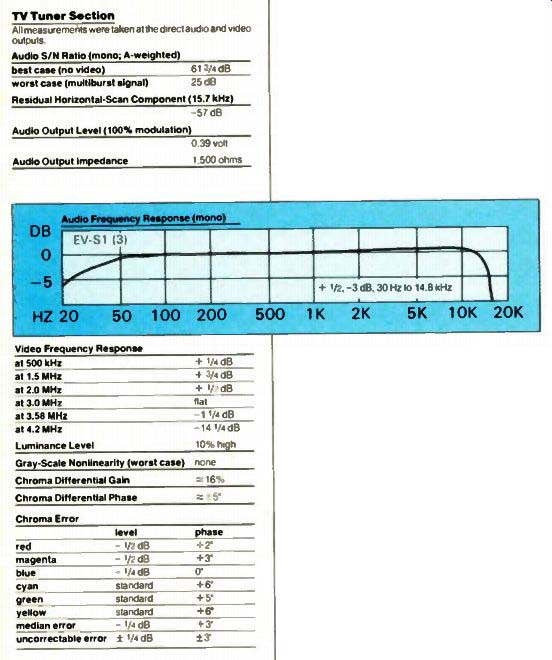
Dimensions: Without handle, 11 by 2 3/4 inches (front), 8 1/4 inches
deep plus clearance for controls and connections; with handle, 13 1/4
by 2 3/4 inches (front), 8 3/4 inches deep. Price: $1000.
Warranty: Limited, 90 days parts and labor Manufacturer: Sony Corp., Japan. U.S. Distributor: Sony Corporation of America, Sony Dr., Park Ridge, N.J. 07656.
Anyone accustomed to conventional home VHS or Beta VCRs will be amazed by the miniscule size of Sony's EV-S1 8mm deck, which the manufacturer bills as a "transportable" VCR. The EV-S1 weighs a mere W. pounds, comes with a detachable handle and a carrying case, and operates either from a 120-volt power line or (via the optional DCC-S1 cable) from a 12- or 24-volt car cigarette lighter.
Sony has packed an incredible number of features into this tiny package: a cable-compatible MTS (stereo TV) tuner with SAP (secondary audio program) reception, a three-event/two-week program timer, high-quality mono recording using a frequency-modulation sys tem similar to Beta Hi-Fi, stereo recording using the 8mm PCM (digital) recording system, double-speed play back with sound, a comprehensive wire less remote control that also fits in the carrying case, and a "theater sound" sys tem said to produce three-dimensional sound effects. Furthermore, the EV-S1 is quite easy to use, thanks to a less daunting array of controls than is typical of VCRs with an equivalent number of features.
------------
VCR Section: Except where otherwise indicated, the recording data shown here apply to both speeds-SP and LP All measurements were made at the direct audio and video out puts, with test signals injected through the direct audio and video inputs The 0-dB reference input level is the voltage at which the automatic level control (ALC) produces 3 dB of compression at 315 Hz The 0-dB reference output level is the output voltage from a 0-db input.


--------------

The EV-S1 is a top-loading design with controls on the top and front panels. Transport controls and the eject but ton are on top. Programming controls, which are unusually simple to decipher, are behind the front-panel door beneath the display area. There are front-panel mini-jacks for a headphone (with volume control) and for a stereo microphone.
The least-often-used controls-hid den beneath a top-panel lid-include the channel-preset controls, which double as automatic or manual fine-tuning adjustments. The EV-S1's tuner covers VHF channels 2 through 13, UHF channels 14 through 69, and cable channels 1, 14 to 36, and 66 to 125--that's 152 channels in all. Of these, as many as 99 channels can be preset into memory, scanned via the channel buttons on the front panel or the remote, or tuned directly by number via the remote's numerical keypad. In addition to duplicating the VCR's transport controls, the remote is the only way to access the super-slow mode Wm normal speed playback) and the frame-advance and theater-sound features.
Also beneath the top-panel lid is an antenna-select switch. Its automatic set ting is recommended for use with conventional TV sets, which will receive the video and monophonic audio on Channel 3 or 4. The antenna-select's manual setting is recommended for use with a monitor, but this setting precludes re cording one program while viewing an other (since the monitor will be receiving only the channel the EV-S1 is set to). To the right of the antenna-select switch are three rather difficult-to-manipulate rotary knobs, one for adjusting sharpness and the other two for tracking in the slow-motion and still-frame modes. The 8mm system automatically adjusts tracking during normal playback. A switch turns the sound on or off when scanning through a tape using the double-speed playback feature.
Additional top-panel controls include an edit switch for copying tapes from the EV-S1. Other switches select between the main and SAP audio channels, turn automatic-stereo reception on and off (which permits mono listening), and select among PCM, AFM, and mixed PCM/AFM audio playback.
When this last switch is in its PCM (Auto) position, the deck plays the stereo digital-audio tracks; if nothing has been recorded in the PCM mode, the deck reverts to the monophonic AFM track.
When the switch is in its STD position, the AFM track plays. You can also re cord the SAP portion of a broadcast on the AFM track and the main stereo broadcast on the PCM tracks. An input selector cycles among three audio-video input possibilities: audio and video from the tuner, audio and video from the line inputs, or audio from the line inputs and video from the tuner (for simulcast re cording). For avid home-video buffs, an insert button facilitates editing by placing the deck in "insert standby" mode from which it immediately begins recording when you release PAUSE -you don't have to wait through the 8mm tape threading procedure. AUDIO DUB permits the rerecording of the PCM stereo tracks without affecting the video or the AFM track.
The yellow-green indicators (clock time, tape counter, various mode indicators, etc.) on the front panel are rather dimly lit and are located behind what seems to be a magnifying lens, restricting their visibility. However, this will be a problem only under very bright light or from off-axis.
On the rear panel are a pair of F connectors for the antenna or cable inputs and outputs and a set of video/stereo audio inputs and outputs. Also on the rear panel are a special DC input jack for external battery operation, a stereo mini jack for headphones or a pair of powered speakers, and a mini-jack input labeled CONTROL-S that connects the EV-S1 with another Sony VCR or, via a Sony RM-E100V Video Editing Controller, with an appropriate Sony camcorder for easy editing. This connection enables re cording start/stop on the EV-S1 to be synchronized with playback start/stop on the ancillary VCR. For ultra-accurate edits, a multipin transport control jack on the EV-S1 also connects to the E100V editing controller.
The EV-S1 operates at two speeds: The fast speed provides two hours of re cording on a P6-120 cassette, and the slow speed gives you four hours. According to Diversified Science Laboratories' data, video performance at the two speeds differs mainly in horizontal resolution and chroma noise, both of which are naturally better at the faster speed.
On SP recordings, video response is down 6 dB at 2.0 MHz, implying a horizontal resolution of 160 lines-equivalent to that of a good conventional VCR operated at its fastest speed. In the slower LP mode, response is down by 5 1/4 dB at 1.5 MHz and 9 dB at 2.0 MHz for a calculated resolution of approximately 130 lines.
Luminance level is almost the same at both speeds and very close to the mark.
Gray-scale linearity is slightly better at the faster speed but is well within acceptable bounds at either. Chroma differential gain (change in color saturation with brightness) and chroma differential phase (change in tint with brightness) are negligible, and there is no measurable chroma phase error. Chroma level is slightly low but closer to the mark than we usually find on full-size VCRs.
The EV-S1 sets audio recording level automatically on both the AFM and PCM tracks. While this makes the deck easy to use and appears to be the de facto standard for recent 8mm home decks, it precludes the recording quality possible with careful manual level setting. Following its new practice, DSL established the point of 3-dB compression as a reference level. Above this point, a very "tight" ALC (automatic level control) comes into play and prevents higher re cording levels except on brief bursts.
Audio output at the reference level depends on whether you're playing the PCM or AFM track. In either case, it should be adequate to drive an amplifier.
Audio output from the tuner is close to that from the deck; hence, there are no substantial shifts in level regardless of the source. Output impedance is low enough to drive reasonable cable lengths and should cause just a minor drop in level when driving a conventional amplifier. The audio input impedance is high enough so as not to tax any conventional source.
The audio line-input sensitivities for reference level suggest that the ALC will rarely come into play with most program sources. We view this as an advantage, since the ALC cannot be defeated. The overload point of the microphone input is a mere 8.2 mV, suggesting that you use a low-output microphone with the EV S1 (and even then, don't hold it too close to the sound source).
As we've found with other 8mm VCRs, audio performance is at least as good on the monophonic AFM track as on the stereo PCM track. Although the latter is digital, the relatively low sampling rate and small number of bits used to characterize the data preclude full CD sound quality. At the reference level, the monaural AFM system shows signs of overload above 4 kHz due to the pre emphasis used. But considering the energy distribution of typical program material, this should be of little concern.
AFM distortion at 10 dB below reference level remains well under 0.5 percent from 50 Hz to 6.3 kHz and just approaches 0.8 percent at 10 kHz. On the digital stereo tracks, distortion is some what higher, and rather strong aliasing components (approaching 30 percent distortion) are generated as the recording frequency approaches the theoretical high-frequency limit at around 15 kHz.
Stereo separation measures a respectable if not stellar 46 dB at 315 Hz. Flutter is below reporting limits at both speeds on the AFM track and quite negligible (+0.017 percent) with PCM recording.
Tuner audio response matches the fine response of the AFM track very closely, while tuner signal-to-noise ratio is an excellent 6P/4 dB with the video suppressed. The noise remains quite low except under the worst video test-pattern conditions. The horizontal-scan whistle is well-suppressed by a sharp notch filter at 15.7 kHz.
The tuner's video performance is excellent, with very flat response to 3.58 MHz (implying a resolution in excess of 300 lines), near-perfect chroma level and phase accuracy, and absolutely perfect gray-scale linearity. Luminance level is just slightly high, while chroma differential phase is adequately low. The 16-percent chroma differential phase reported by DSL occurs entirely at the brightest scene level and should therefore be of minor concern.
In the viewing room, performance was eminently satisfying. Resolution at the SP speed was at least on a par with that of a good half-inch standard-format VCR; luminance and chrominance noise were, if anything, better than we've come to expect from standard VCRs. Noise bars appear during the cue and review modes (operated by pressing rewind or fast-forward during playback), but double-speed and still-frame playback were perfect on an SP-recorded tape. On an LP tape, there was a certain amount of vertical jitter with double-speed play back, yet still-frame remained excellent.
Jitter in the slow mode is unlikely to be objectionable on tapes recorded at either speed.
From a technical standpoint, we have few complaints about the Sony EV-S1.
Its video performance is at least equivalent to that of a conventional half-inch VCR (and better than on many). Its tuner section would be superb even in a high-resolution monitor/receiver, let alone in a VCR. Sony has managed to cram a lot of hardware into a tiny and effective package. But what else would you expect from the folks who brought us the Walkman?
Also see: